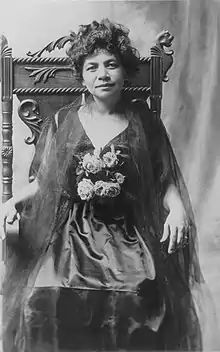The election of women to the Hawaii Territorial Legislature was a complex process. Women did not have the right to vote in the Republic of Hawaii after the overthrow of the Hawaiian Kingdom. Upon the passage of the Nineteenth Amendment to the United States Constitution, women gained suffrage almost immediately began seeking election to the Territorial Legislature, but the Hawaiian Organic Act dictated that only "a male citizen of the United States" could hold territorial office.
Background
After the overthrow of the Hawaiian Kingdom by white businessmen in 1893, the new rulers barred women from voting in the elections of the new Republic of Hawaii. The overthrow therefore led to a reduction in the rights of women to be involved in government in Hawaii. Hawaiian culture historically involved a matriarchal understanding of power. Under the constitutional monarchy of the Hawaiian Kingdom prior to the overthrow, the common women could not vote but noble women could serve as ambassadors, judges, governors, and could become monarch.[1]
Emma Nakuina and Wilhelmine Dowsett began organizing for women's suffrage shortly after the overthrow, with Dowsett founding the National Women's Equal Suffrage Association of Hawai'i in 1912. Continued suffrage organizing by a multi-ethnic group of women in Hawaii played a role in the eventual ratification of the Nineteenth Amendment to the United States Constitution on August 18, 1920, granting women the right to vote.[1]
Very soon after the passage of the amendment, women began seeking election to the Hawaii Territorial Legislature. This had been understood as a part of the goal of the suffrage movement in Hawaii, influenced by the extent of women's political power prior to the overthrow.[1]
Initial campaigns and eligibility

Women who sought election to the Territorial Legislature immediately after the ratification of the 19th Amendment were apparently unaware that the amendment only gave them the right to vote, and not necessarily the right to hold elected office.[1] In October 1920, Mary Haʻaheo Atcherley of Oahu was running for Territorial Senate as a Democrat, and Helen Sniffen of Maui was seeking a seat as well. Curtis P. Iaukea, then Territorial Secretary, did not believe he had the authority to remove the women's names from the ballot and deferred the issue to Attorney General Harry Irwin. Irwin ruled that the women's names could not legally be removed from the ballot, but also stated that they were not eligible for office under Section 24 of the Hawaiian Organic Act which stated that only "a male citizen of the United States" would have the right to hold territorial office.[2][3]
In 1922, Atcherley once again campaigned for office; advice received by Territorial Governor Wallace Rider Farrington from the United States Department of the Interior, responsible for the administration of the Territory of Hawaii, aligned with Irwin's 1920 ruling.[4] However, in June 1922, a bill modifying the Organic Act to allow women to hold office in Hawaii passed in the United States House of Representatives. On September 1, 1922, the bill passed in the United States Senate as well, with the President expected to sign shortly after. The bill's passage fulfilled a campaign promise by Harry A. Baldwin, Congressional delegate for the Territory of Hawaii; Atcherley's campaigns for office were noted as further impetus for the change.[5] The bill prompted calls for prominent women in the territory to seek office, although as of September 2 it remained unclear whether they would be eligible for election, as President Warren G. Harding had not yet signed and the nomination deadline was September 7.[6] Harding signed the bill into law on September 15, 1922.[7]
First successful campaigns
Rosalie Keliʻinoi
In 1925, Rosalie Keliʻinoi became the first woman elected to the Hawaii Territorial Legislature and specifically the Hawaii Territorial House of Representatives.[8]
Elsie Wilcox
In 1933, Elsie Wilcox became the first woman elected to the Hawaii Territorial Senate.[8]
Disestablishment of Hawaii Territorial Legislature
The Hawaii Territorial Legislature adjourned for the final time on May 2, 1959, when Hawaii became a state and the Hawaii State Legislature therefore became its legislative body.[9]
References
Citations
- 1 2 3 4 McGreevy 2020.
- ↑ Apple & Apple 1971.
- ↑ Morning Oregonian 1920.
- ↑ The Maui News 1922a.
- ↑ The Maui News 1922b.
- ↑ The Daily Post Herald 1922.
- ↑ Honolulu Star-Bulletin 1922.
- 1 2 NCSL 2019.
- ↑ "HAWAII: The Souvenir Collectors". Time. June 22, 1959. ISSN 0040-781X. Retrieved April 29, 2022.
Works cited
- Cox, Elizabeth (1996). Women, state, and territorial legislators, 1895 - 1995: a state-by-state analysis, with rosters of 6,000 women. Jefferson, NC: McFarland. ISBN 978-0-7864-0078-2.
- McGreevy, Nora (August 13, 2020). "How the 19th Amendment Complicated the Status and Role of Women in Hawai'i". Smithsonian Magazine. Retrieved January 6, 2024.
- Apple, Russ; Apple, Peg (October 6, 1971). "This day in our Hawaiian history". Honolulu Star-Bulletin. p. 23. Retrieved January 6, 2024 – via Newspapers.com.
- "Hawaii women now have right to hold office". Honolulu Star-Bulletin. September 20, 1922. Retrieved January 6, 2024.
- "Women May Run For Office, But Rest Doubtful". The Maui News. February 10, 1922. Retrieved January 6, 2024.
- "Women Of Hawaii Eligible To Seat In Legislature". The Maui News. September 1, 1922. ISSN 8750-457X. Retrieved January 6, 2024.
- "Hawaiian Women Barred". Morning Oregonian. October 23, 1920. p. 3. Retrieved January 6, 2024.
- "Women preparing to make campaign for legislature". The Daily Post Herald. September 2, 1922. Retrieved January 6, 2024 – via Newspapers.com.
- "First Women to Serve in State and Territorial Legislatures". National Conference of State Legislatures. March 6, 2019. Retrieved January 6, 2024.